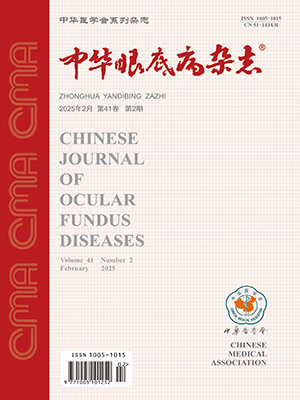| 1. |
Querques G, Kuhn D, Massamba N, et al. Perifoveal exudative vascular anomalous complex[J]. J Fr Ophtalmol, 2011, 34(8): 559. DOI: 10.1016/j.jfo.2011.03.002.
|
| 2. |
梁雨辰, 段佳良, 尚庆丽. 黄斑中心凹旁渗出性血管异常复合体研究进展[J]. 中华眼底病杂志, 2022, 38(5): 415-419. DOI: 10.3760/cma.j.cn511434-20200318-00146.Liang YC, Duan JL, Shang QL. Advances in the study of perifoveal exudative vascular anomalous complex[J]. Chin J Ocul Fundus Dis, 2022, 38(5): 415-419. DOI: 10.3760/cma.j.cn511434-20200318-00146.
|
| 3. |
Smid LM, Verhoekx JSN, Martinez Ciriano JP, et al. Multimodal imaging comparison of perifoveal exudative vascular anomalous complex and resembling lesions[J]. Acta Ophthalmol, 2021, 99(5): 553-558. DOI: 10.1111/aos.14650.
|
| 4. |
Sacconi R, Freund KB, Yannuzzi LA, et al. The expanded spectrum of perifoveal exudative vascular anomalous complex[J]. Am J Ophthalmol, 2017, 184: 137-146. DOI: 10.1016/j.ajo.2017.10.009.
|
| 5. |
Mrejen S, Le HM, Nghiem-Buffet S, et al. Insights into perifoveal exudative vascular anomalous complex[J]. Retina, 2020, 40(1): 80-86. DOI: 10.1097/IAE.0000000000002435.
|
| 6. |
Fernández-Vigo JI, Burgos-Blasco B, Dolz-Marco R, et al. Atypical perifoveal exudative vascular anomalous complex (PEVAC) with multifocal and bilateral presentation[J/OL]. Am J Ophthalmol Case Rep, 2020, 18: 100717[2020-04-21]. https://linkinghub.elsevier.com/retrieve/pii/S2451-9936(20)30071-2. DOI:10.1016/j.ajoc.2020.100717.
|
| 7. |
Sacconi R, Borrelli E, Sadda S, et al. Nonexudative perifoveal vascular anomalous complex: the subclinical stage of perifoveal exudative vascular anomalous complex?[J]. Am J Ophthalmol, 2020, 218: 59-67. DOI: 10.1016/j.ajo.2020.04.025.
|
| 8. |
Zhang Z, Xu L, Wu Z, et al. Case report: perifoveal exudative vascular anomalous complex in a Chinese patient with diabetes mellitus[J]. Optom Vis Sci, 2019, 96(7): 531-535. DOI: 10.1097/OPX.000000000000140.
|
| 9. |
Sacconi R, Borrelli E, Bandello F, et al. Perifoveal exudative vascular anomalous complex in a highly myopic eye[J/OL]. Ther Adv Ophthalmol, 2020, 12: 2515841420947930[2020-09-11]. https://pubmed.ncbi.nlm.nih.gov/32964194/. DOI:10.1177/2515841420947930.
|
| 10. |
Kim JH, Kim JW, Kim CG, et al. Characteristics of perifoveal exudative vascular anomalous complex in Korean patients[J]. Semin Ophthalmol, 2019, 34(5): 353-358. DOI: 10.1080/08820538.2019.1626450.
|
| 11. |
Yannuzzi LA, Bardal AM, Freund KB, et al. Idiopathic macular telangiectasia[J]. Arch Ophthalmol, 2006, 124(4): 450-460. DOI: 10.1001/archopht.124.4.450.
|
| 12. |
Yannuzzi LA, Freund KB, Takahashi BS. Review of retinal angiomatous proliferation or type 3 neovascularization[J]. Retina, 2008, 28(3): 375-384. DOI: 10.1097/IAE.0b013e3181619c55.
|
| 13. |
Su D, Lin S, Phasukkijwatana N, et al. An updated staging system of type 3 neovascularization using spectral domain optical coherence tomography[J]. Retina, 2016, 36 Suppl 1: S40-49. DOI:10.1097/IAE.0000000000001268.
|
| 14. |
汤稷旸, 韩馨瑶, 汤然, 等. 黄斑中心凹旁渗出性血管异常复合体临床特征及多模式影像特征观察[J]. 中华眼底病杂志, 2022, 38(11): 885-890. DOI: 10.3760/cma.j.cn511434-20211206-00685.Tang JY, Han XY, Tang R, et al. Clinical characteristics and multimodal imaging of perifoveal exudative vascular anomalous complex[J]. Chin J Ocul Fundus Dis, 2022, 38(11): 885-890. DOI: 10.3760/cma.j.cn511434-20211206-00685.
|
| 15. |
Gawęcki M. Micropulse laser treatment of retinal diseases[J]. J Clin Med, 2019, 8(2): 242. DOI: 10.3390/jcm8020242.
|
| 16. |
Kang YK, Park HS. Multiple-session subthreshold micropulse laser therapy for exudative perifoveal vascular anomalous complex: a case report[J]. Retin Cases Brief Rep, 2023, 17(3): 324-328. DOI: 10.1097/ICB.0000000000001181.
|
| 17. |
Henriques J, Pinto F, Rosa PC, et al. Continuous wave milipulse yellow laser treatment for perifoveal exudative vascular anomalous complex-like lesion: a case report[J]. Eur J Ophthalmol, 2022, 32(1): NP119-NP124. DOI: 10.1177/1120672120966564.
|
| 18. |
Remolí-Sargues L, Montero-Hernández J, Monferrer Adsuara C, et al. Perifoveal exudative vascular anomalous complex treated with navigated retina laser[J]. J Fr Ophtalmol, 2022, 45(1): e9-e11. DOI: 10.1016/j.jfo.2021.03.011.
|




